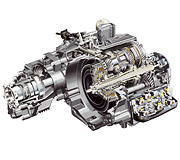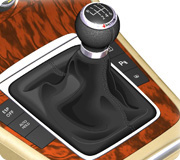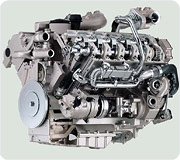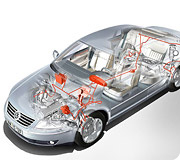|

|
Dual Clutch Gearbox
|
|
The latest innovation from Volkswagen's transmission development department is the DSG® dual-clutch gearbox. What makes the fully automatic six-speed gearbox truly stand out is that it
allows gearshifts to be made without any interruption to the power flow. Consequently, the gear changes are extremely smooth and barely perceptible to the occupants. The dual-clutch
gearbox features two wet clutches acting via two drive shafts, with clutch 1 engaging 1st, 3rd, 5th and reverse gear and clutch 2 responsible for engaging 2nd, 4th and 6th gear. When
a gear change is made, the next gear is already pre-selected but not yet engaged. It takes just three to four hundredths of a second for one clutch to engage while the other is released.
This enables gearshifts to be performed without the driver even being aware and without any break in the power flow. Depending on the preferred driving style, the intelligent control
electronics allow fuel savings of up to 10 percent to be made compared to a 6-speed manual gearbox. The driver can operate the DSG® gearbox manually or allow gear changes to take
place automatically. In the automatic mode there is a choice between the well-balanced, extremely smooth standard shift setting and a shift mode with a much more sporty emphasis.
Manual shifts are made either at the selector lever or using the shift paddles or buttons on the steering wheel
|
|
|
|

|
Auto Hold function
|
|
The Auto Hold function in Volkswagen's new Passat and Passat Estate is an extension of the electronic parking brake. The Auto Hold function prevents the vehicle from rolling away accidentally
when standing still or when setting off. In this way Auto Hold offers the ultimate in convenience and comfort when driving or setting off, along with enhanced safety. The system is
operated via the ABS/ESP hydraulic unit. When the vehicle is braked to a standstill, Auto Hold retains the last-applied braking pressure. The driver can take his/her foot from the
brake pedal and all four wheel brakes will remain on. If the ABS wheel speed sensors detect any rolling, the braking force is automatically increased until the vehicle comes to a
standstill again. This may be the case if, for example, the driver brakes gently to a stop on an incline. As soon as the driver presses the accelerator again and, in the case of manual
gearboxes, releases the clutch, Auto Hold reduces the braking pressure once more. For safety reasons the function always has to be reactivated by means of a button to the left of
the gear lever when the engine has been switched off.
|
|
|
|

|
TDI
|
|
Volkswagen has many years' experience in TDI technology. In many countries, TDI is a registered trademark of Volkswagen AG. The TDI badge identifies all the Group's diesel-powered models
featuring diesel direct injection and a turbocharger. Characteristic features of the TDI engines are fuel economy, low emissions, high pulling power (torque) and outstanding power
efficiency. Functionality: A turbocharger supplies the engine with fresh air, thereby providing optimum cylinder charging. After compression, the diesel is injected directly into
the cylinders at very high pressure by way of a nozzle. Effective engine encapsulation keeps noise to a minimum, while hydraulic engine mounts ensure smooth, low-vibration running.
|
|
|
|

|
Electronic Stabilisation Program
|
|
The electronic stabilisation program detects critical driving situations, where there is a risk of the vehicle skidding for example, and implements effective measures to prevent the vehicle
from breaking away. To enable the electronic stabilisation program to respond to such critical situations, the system must be fed constantly with data: for example, what direction
the driver is steering in and what direction the vehicle is moving in. The answer to the first of these questions is provided by the steering angle sensor and the ABS speed sensors
on the wheels. These two items of information allow the control unit to calculate the target steering direction and the target vehicle behaviour. Additional key data include the yaw
rate and the lateral vehicle acceleration. The control unit uses this information to calculate the vehicle's actual status. The electronic stabilisation program prevents the vehicle
from being destabilised when cornering as a result of either excessive speed, an unexpected change in the road surface (water, ice, dirt) or the driver having to perform a sudden
evasive manoeuvre ("elk test" situation). The system takes corrective action regardless of whether the instability manifests itself as understeer - when the vehicle slides
towards the outside of the bend despite the wheels being turned in the opposite direction - or oversteer, when the vehicle's tail swerves out. The electronic stabilisation program's
computer unit uses the data supplied by the network of sensors to determine the nature of the vehicle's instability and governs the corrective response by intervening in the braking
and engine management systems. If the vehicle is understeering, the electronic stabilisation program decelerates the rear wheel on the inside of the bend. At the same time, it reduces
engine power until stability has been restored. The electronic stabilisation program counters oversteer by carefully applying the front brake on the outside of the bend and intervening
in the engine and transmission management. This complex control system is subject to ongoing advancement as more and more experience with it is gained and sensors are developed which
offer far greater sensitivity. Note: The electronic stabilisation program is unable to override the limits imposed by the laws of physics. If the driver pushes both the chassis and
the electronic stabilisation program beyond their limit, not even ESP will be able to prevent an accident.
|
|
|
|